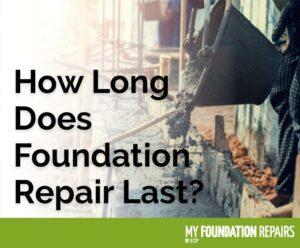How Long Does Foundation Repair Last?
If your home has foundation problems like bowed walls or massive wall cracks, you likely have a problem with the foundation that should be repaired as soon as possible. While some foundation repair techniques are intended to solve minor issues like hairline cracks, long-term foundation repair solutions should last for at least a few decades and should come with a lifetime warranty.
Temporary repairs like polyurethane sealant or masonry patches are akin to putting a bandaid on a scratch or minor cut. Usually, the scratch is nothing to worry about. However, if the cut gets infected, it requires a much higher level of care (and expense) to treat.

The same goes for seemingly minor cracks or sagging floors. Over time, they will need more elaborate solutions, like unpinning techniques using helical piers or other reinforcements like concrete or steel piers. Other less major, but still effective, methods include slab jacking, spot piers, or segmented piers, which are essentially spot treatments for sloping areas of your foundation.
So the answer to the question, “How long does foundation repair last?” is, “It depends on the repair method utilized for your particular situation.” Quick-fix solutions will likely last five years or so, while an investment involving steel, anchors, or other heavy-duty repairs should last at least a few decades, if not a lifetime.
Types of Repair Methods
If you utilize a professional company to conduct your repairs for you, they should be able to guarantee that their labor lasts a lifetime or at least twenty five years, on average. Here are more details about each of the various foundation repair methods:
- Epoxy Fills: A quick-fix, DIY solution that repairs surface damage like hairline cracks and often lasts five years or more.
- Carbon Fiber Straps/Wall Anchors: These types of heavy-duty fixes for bowed walls often last several years, if not a decade or more.
- Polyurethane Lift: This method involves injecting polyurethane foam into the ground beneath the broken foundation area. As the foam dries and hardens, it lifts the foundation into place and restores it to a level position. Polyurethane foam doesn’t deteriorate or weaken over time, so it is considered a permanent repair solution.
- Helical Piers: These resemble giant screws that are twisted into the ground beneath a damaged foundation, often used for foundations supporting less weight, such as a porch or garage. In order for helical piers to last as long as possible, installers should check the soil conditions before installing them, so as to know how deep to drive the piers.
- Concrete Piers: These are often installed during the preconstruction phase of homebuilding, and they help support a foundation as it’s being poured. These types of piers are also used for sinking foundations by lifting them up and providing added support.
- Steel Piers: Similar to concrete piers, steel piers are easier to work with and can be installed more readily. Concrete requires pouring while fresh, and may disturb more landscaping and lawn than simple steel piers. Steel is also more resistant to moisture and added weight than concrete piers.
We hope that you now feel more informed about different types of foundation repair methods available to you. In We hope that you now feel more informed about different types of foundation repair methods available to you. In addition to improving living conditions for you and your family, a well-built foundation will also increase your home’s resale value when the time comes.
If you find yourself in the market for foundation repair, My Foundation Repairs is here to serve you and help you find foundation repair professional contractors near you. Contact us for a free consultation today!
